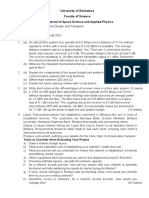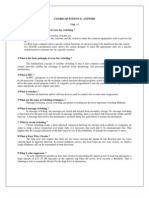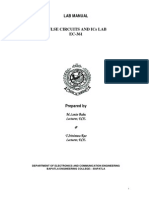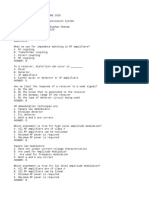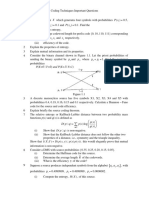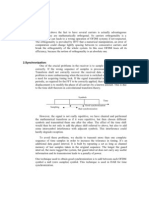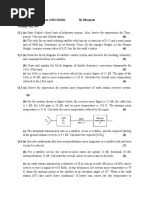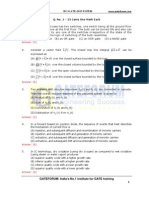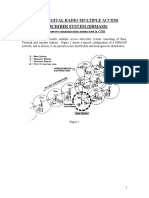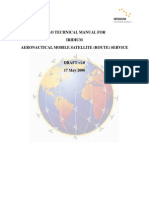HT TP: //qpa Pe R.W But .Ac .In: Satellite Communication
HT TP: //qpa Pe R.W But .Ac .In: Satellite Communication
Uploaded by
smrahimCopyright:
Available Formats
HT TP: //qpa Pe R.W But .Ac .In: Satellite Communication
HT TP: //qpa Pe R.W But .Ac .In: Satellite Communication
Uploaded by
smrahimOriginal Description:
Original Title
Copyright
Available Formats
Share this document
Did you find this document useful?
Is this content inappropriate?
Copyright:
Available Formats
HT TP: //qpa Pe R.W But .Ac .In: Satellite Communication
HT TP: //qpa Pe R.W But .Ac .In: Satellite Communication
Uploaded by
smrahimCopyright:
Available Formats
Name :
/q
p:/
htt
Roll No. : ..
Invigilators Signature : ..
CS/M.TECH (ECE)/SEM-2/MCE-205A/2013
2013
SATELLITE COMMUNICATION
Time Allotted : 3 Hours
Full Marks : 70
The figures in the margin indicate full marks.
pap
Candidates are required to give their answers in their own words
as far as practicable.
wb
er.
GROUP A
( Multiple Choice Type Questions )
1.
Choose the correct alternatives for any ten of the following :
i)
10
1 = 10
In a circular geostationary orbit in the equatorial plane
the apogee equals the perigee
b)
the apogee is twice the perigee
c)
the perigee is twice the apogee
d)
none of these.
30715 (M.Tech)
in
a c.
ut .
a)
[ Turn over
CS/M.TECH (ECE)/SEM-2/MCE-205A/2013
ii)
For an eccentric elliptical orbit with eccentricity ( e )
/q
p:/
htt
and semi-major axis ( a ), the perigee point distance
from the centre of earth having radius ( R ) is given by
rp = a ( 1 e ) / R
b)
rp = a ( 1 e )
c)
rp = a ( 1 + e )
d)
r p = aR / ( 1 e ) .
pap
iii)
a)
Satellite may reuse the same frequency in the same
area by
having many small antennas
b)
overlapping radiation zones
c)
TDMA
d)
FDMA.
wb
er.
The conversion efficiency of solar cell is about
a)
12% to 15%
b)
15% to 20%
c)
12% to 25%
d)
none of these.
30715 (M.Tech)
in
a c.
ut .
iv)
a)
CS/M.TECH (ECE)/SEM-2/MCE-205A/2013
v)
For the earth station antennas to be 6 feet in diameter,
/q
p:/
htt
the satellite frequency bands much be in
b)
12/14 GHz range
c)
20/30 GHz range
d)
Both (a) and (b)
Earth station figure of merit is defined as
a)
10 log ( G/T )
b)
10 log ( GT )
c)
20 log ( G/T )
d)
None of these.
wb
er.
vii)
4/6 GHz range
pap
vi)
a)
A satellite earth station antenna has a gain of 10 6 and
a noise temperature of 100K. The earth station ( G/T )
in dB/K is
a)
40 dB/K
c)
Indeterminate
b)
80 dB/K
d)
Zero.
in
a c.
ut .
viii) A 10 GHz signal was beamed up at a satellite at a
distance of about 40,000 km from the earths surface.
The signal undergoes a free space loss of
a)
10 db
b)
50 dB
c)
200 dB
d)
385 dB.
30715 (M.Tech)
[ Turn over
CS/M.TECH (ECE)/SEM-2/MCE-205A/2013
ix)
The code division multiple access technique is not
/q
p:/
htt
usually used because
a)
it requires very large bandwidth
b)
the circuity required is very complex
c)
the system becomes too expensive
d)
its technology has not been completely developed
as yet.
pap
x)
The multiple access technique in which full bandwidth
is used for full time by all users is
FDMA
b)
CDMA
c)
TDMA
d)
none of these.
wb
er.
xi)
a)
The time duration between the transmissions of traffic
a)
125 sec
b)
120 sec
c)
64 sec
d)
250 sec.
30715 (M.Tech)
in
a c.
ut .
bursts in TDMA is
CS/M.TECH (ECE)/SEM-2/MCE-205A/2013
xii)
The drop size distribution is given by ( the notations
/q
p:/
htt
have their usual significance )
D
Dm
a)
N ( D ) = N 0 exp
b)
N ( D ) = N 0 exp
D
Dm
c)
N ( D ) = N 0 exp
d)
N ( D ) = N 0 exp
Dm
D
Dm
pap
xiii) Generally the VSAT network is operated in
FDMA mode
b)
TDMA mode
c)
CDMA mode
d)
None of these.
wb
er.
a)
xiv) The type of configuration used in VSAT system is
Hybrid
b)
Data
c)
Mesh
d)
Star.
30715 (M.Tech)
in
a c.
ut .
a)
[ Turn over
CS/M.TECH (ECE)/SEM-2/MCE-205A/2013
GROUP B
/q
p:/
htt
( Short Answer Type Questions )
Answer any three of the following.
2.
a)
5 = 15
What do you mean by apogee and perigee heights ?
Illustrate Look angles.
b)
A satellite is in an elliptical orbit with apogee and
perigee
heights
being
4000
km
and
500
km
pap
respectively. Determine the eccentricity, semi major
and semi minor axes. Find also the orbital period of the
satellite. Take radius of each as 6370 km.
4.
wb
er.
3.
Illustrate the following :
a)
Altitude Control System ( ACS )
b)
Orbit Control System ( OCS ).
Elucidate Telemetry, Tracking, Command and Monitoring
in
a c.
ut .
( TTC&M ) in the context of operation of a communication
satellite.
5.
Name different antenna systems which are sued in satellite
communication. State and explain the factors on which the
selection of antenna depends.
30715 (M.Tech)
1+4
CS/M.TECH (ECE)/SEM-2/MCE-205A/2013
6.
In a satellite communication, the output power of a satellite
/q
p:/
htt
transponder is 20 W with output back off 10 dB. The gain
of the satellite antenna and earth station antennas are
300 dB and 592 dB respectively. Given, free loss at 4 GHz
is 1950 dB, beam loss is 20 dB, atmosphere loss is 02 dB
and other losses are 04 dB. Calculate the power received at
earth station.
pap
7.
State the purpose of a transponder ? With the help of a
diagram, describe the working of a typical single conversion
transponder for 6/4 GHz links.
1+4
wb
er.
GROUP C
( Long Answer Type Questions )
Answer any three of the following.
8.
a)
15 = 45
Develop Friis transmission equation regarding power
received by antenna. Also, deduce the relation between
b)
2+3
in
a c.
ut .
C/N and G/T ratio.
An antenna is matched into a receiver. The noise
temperature of the antenna and the receiver are 40 K
and 100 K respectively. If the receiver band width is
36 MHz, determine its noise power.
( k = 138
30715 (M.Tech)
10 23 J/K
).
[ Turn over
CS/M.TECH (ECE)/SEM-2/MCE-205A/2013
c)
Determine the value of overall carrier to noise ratio in a
/q
p:/
htt
satellite link where a signal is transmitted to a satellite
transponder with a carrier to noise ratio of 15 dB and
transponder transmits it with the said ratio of 20 dB. 5
d)
What do you understand by multiple accesses in the
context of satellite communication ? What are the
various techniques used for this purpose ?
9.
a)
Distinguish
between
pre-assigned
and
2+1
demand-
pap
assigned techniques, stating the relative advantages
and disadvantages.
b)
Briefly
describe
the
operational
principles
of
wb
er.
frequency division multiple access ( FDMA ) system.
What is the significance of guard band ?
c)
5+2
Develop the expression for the required carrier to noise
ratio in FDMA system in both SCPC and MCPC types. 5
10. a)
Illustrate the functional principle of a time division
multiple access ( TDMA ) system. How one can
in
a c.
ut .
distinguish between time division multiplexing ( TDM )
and TDMA ? Why TDMA is used with digital signals
only ?
b)
3+1+1
Define TDMA frame. What are the constituents of a
TDMA frame structure ? Briefly describe the purpose of
each constituent part of a TDMA frame.
30715 (M.Tech)
1+1+3
CS/M.TECH (ECE)/SEM-2/MCE-205A/2013
c)
A TDMA network of five earth stations shares a single
/q
p:/
htt
transponder equally. The frame duration is 20 ms, the
preamble time per station is 20 s and guard bands of
5 s are used between bursts. Transmission bursts are
QPSK at 30 Mbaud. Calculate the number of 64 Kbps
voice channels that each TDMA earth station can
transmit. Taking bits are being sent as 500 bursts/s,
find how guard time per burst is affected when the
fractional channel is ignored.
11. a)
3+2
Illustrate, (i) Spade system, (ii) Code Divison Multiple
pap
Access ( CDMA ) and (iii)
Space Domain Multiple
Access ( SDMA ).
b)
Three identical large earth stations shared a single
36 MHz band width transponder using FDMA with the
wb
er.
three earth stations transmitting signals of band width
15 MHz, 10 MHz and 5 MHz respectively. The three
earth station accesses are changed to TDMA with a
frame length of 10 ms, a preamble time of 10 s and a
guard time of 2 s. There is no reference burst in
TDMA frame. The signals are transmitted using QPSK.
Find out the burst symbol rate on the link. Find also
c)
4+1
in
a c.
ut .
the burst duration for each earth station.
Write down the general expression for attenuation
involving rain rate and path length in air. Find the
specific attenuation at 10 GHz, if the rain fall rate is
40 mm/hour and linear vertical polarization is used.
( Given, a v = 000887, b v = 1264 at 10 GHz )
1+2
30715 (M.Tech)
[ Turn over
CS/M.TECH (ECE)/SEM-2/MCE-205A/2013
d)
/q
p:/
htt
A 12 GHz direct broadcast satellite link was found to
experience 4 dB rain attenuation at an elevation angle
of 45 for 001% of the time in an average year. What
will be the rain attenuation measured at the same time
percentage for the same site if the elevation angle were
10 ?
2
Write down the key equation in the link power budget,
stating the meanings of all notations used. Describe
briefly how attenuation and depolarization are
quantified.
1+4
b)
Satellite A radiates an EIRP of 35 dB W on the
downlink to an earth station whose antenna gain is
50 dB. Transmission from another satellite B located in
the vicinity of the first satellite produces interference in
the desired downlink. If the EIRP of the interfering
satellite is 30 dB W, determine carrier to interference
ratio ( C/I ), assuming that the path loss on the
downlink channel for both the satellites are the same
and angular separation of both the satellites from the
earth station is 4.
2
c)
In case of uplink, EIRP values of earth stations A and B
are 80 dB W and 75 dB W respectively. The transmit
antenna gains in the two cases are 50 dB each. If the
gain of the receiving antenna of the satellite is 20 dB in
the direction of earth station A and 15 dB in the
direction of earth station B, calculate carrier to
interference ratio at the satellite due to interference
caused by earth station B. Assume, viewing angle of the
satellite from the two earth stations is 4.
3
d)
Illustrate
wb
er.
pap
12. a)
Satellite
( MSAT ).
30715 (M.Tech)
in
a c.
ut .
Mobile
Communication
System
10
CS/M.TECH (ECE)/SEM-2/MCE-205A/2013
13. a)
Explain the important features of VSAT system.
/q
p:/
htt
b)
Using the following data in relation to communication
between VSAT and satellite, calculate ( C/N ) uplink and
( C/N ) downlink and hence ( C/N ) overall .
Transmit power of VSAT = 2 W
ii)
Uplink frequency = 14 GHz
iii)
Diameter of transmit antenna = 2 m
iv)
Efficiency of transmit antenna = 68%
v)
Altitude of satellite = 20,000 km
vi)
Other losses = 5 dB
vii)
Temperature = 500 K
wb
er.
pap
i)
viii) Satellite transmit power = 1 W/channel
ix)
Downlink frequency = 12 GHz
x)
Satellite antenna gain = 28 dB
xi)
Other losses = 2 dB.
11
in
a c.
ut .
30715 (M.Tech)
10
[ Turn over
You might also like
- HFSS ManualDocument1,227 pagesHFSS ManualSonia Baci100% (1)
- Assignment 3Document1 pageAssignment 3Robert Tatenda ZataNo ratings yet
- Satellite Communication Previous Years Question PapersDocument13 pagesSatellite Communication Previous Years Question Papersshankar92% (12)
- Department of Ece Lesson Plan Subject: Subject Code: CLASS: IV Year A' & B'Document5 pagesDepartment of Ece Lesson Plan Subject: Subject Code: CLASS: IV Year A' & B'Balasubramoniam ChokalingamNo ratings yet
- Satellite Communication Previous Years Question PapersDocument13 pagesSatellite Communication Previous Years Question Papersshankar92% (12)
- Cellular Wireless Networks 1Document64 pagesCellular Wireless Networks 1selemondoc100% (1)
- SSMT Solution ManualDocument12 pagesSSMT Solution ManualPraahas Amin0% (1)
- MTSODocument23 pagesMTSOShreya ShekarNo ratings yet
- Cellular System TopologyDocument14 pagesCellular System TopologyWeslie John PabericioNo ratings yet
- Edited 2 MarksDocument24 pagesEdited 2 MarksMohamed RiasNo ratings yet
- A Synchronous Data TransferDocument10 pagesA Synchronous Data Transfersmadi13No ratings yet
- Distributed SPCDocument106 pagesDistributed SPCKamal Singh RathoreNo ratings yet
- CMPE150 Midterm Solutions: Question 1 Packet Switching and Circuit SwitchingDocument11 pagesCMPE150 Midterm Solutions: Question 1 Packet Switching and Circuit SwitchingSimran sandhu100% (1)
- Assignment 3 - Radio Wave PropagationDocument1 pageAssignment 3 - Radio Wave PropagationKisangiri MichaelNo ratings yet
- Chapter 1 - Introduction To The Telephone NetworkDocument9 pagesChapter 1 - Introduction To The Telephone NetworkPoit X Nincompoops100% (1)
- No 4 ESS Toll Switch: K.Manju Shree (2018504556)Document18 pagesNo 4 ESS Toll Switch: K.Manju Shree (2018504556)Manjushree KumaravelNo ratings yet
- Multivibrator Manual PDFDocument73 pagesMultivibrator Manual PDFAvijitRoyNo ratings yet
- Multiple Choice Questions - Wireless CommunicationDocument3 pagesMultiple Choice Questions - Wireless CommunicationEdwin Quinlat DevizaNo ratings yet
- SECTION 4 - RF System DesignDocument44 pagesSECTION 4 - RF System DesignBelachew AndualemNo ratings yet
- Review Question in Data CommunicationDocument5 pagesReview Question in Data Communicationasdfghjkl26No ratings yet
- Microstrip AntennaDocument25 pagesMicrostrip AntennaMegh Patel100% (1)
- 07 Chapter2Document13 pages07 Chapter2Arslan AliNo ratings yet
- Analog CommunicationDocument12 pagesAnalog Communicationबृजभूषणशर्माNo ratings yet
- 20 Multiple Choice Questions and Answers For Personal Communication Systems - RAMON (Revised)Document5 pages20 Multiple Choice Questions and Answers For Personal Communication Systems - RAMON (Revised)Justin Lance RamonNo ratings yet
- Subscriber Loop Design LectureDocument36 pagesSubscriber Loop Design LectureAlas Mallari DonatoNo ratings yet
- EC6801 Unit 2 MCQDocument26 pagesEC6801 Unit 2 MCQVanitha RNo ratings yet
- Lecture Notes-Multiple Antennas For MIMO Communications - Basic TheoryDocument48 pagesLecture Notes-Multiple Antennas For MIMO Communications - Basic TheorygowthamkurriNo ratings yet
- Chapter 4: Mobile Radio Propagation Small-Scale Fading and MultipathDocument43 pagesChapter 4: Mobile Radio Propagation Small-Scale Fading and MultipathAnonymous H6bzpSwYtNo ratings yet
- hAND OFFDocument22 pageshAND OFFjenath1100% (1)
- Digital Communications Questions and Answers PDF FreeDocument2 pagesDigital Communications Questions and Answers PDF FreeOnly Technology.No ratings yet
- Mobile and Wireless Communication - AllDocument12 pagesMobile and Wireless Communication - AllmadhunathNo ratings yet
- Coding Techniques Important Questions-1Document6 pagesCoding Techniques Important Questions-1jaya Sekhar lankelaNo ratings yet
- Binary Erasure Channel (BEC)Document2 pagesBinary Erasure Channel (BEC)Anonymous JXTwISptYANo ratings yet
- CDMA MIMO and OFDM NPTEL NotesDocument9 pagesCDMA MIMO and OFDM NPTEL Notessridhar bodduNo ratings yet
- MCQ - 8 PDFDocument4 pagesMCQ - 8 PDFWillina Marie Chong MableNo ratings yet
- Original PDFDocument28 pagesOriginal PDFAbdelhakim KhlifiNo ratings yet
- Cdma Cdma-BasisDocument55 pagesCdma Cdma-BasisRanjit SinghNo ratings yet
- Electronic SwitchingDocument55 pagesElectronic SwitchingSunny Tyagi VatsNo ratings yet
- Assignment3 SolutionsDocument12 pagesAssignment3 SolutionsabaalharthiNo ratings yet
- Sheet #6 Ensemble + Neural Nets + Linear Regression + Backpropagation + CNNDocument4 pagesSheet #6 Ensemble + Neural Nets + Linear Regression + Backpropagation + CNNrowaida elsayedNo ratings yet
- Advanced Data CommunicationsDocument2 pagesAdvanced Data CommunicationsAlluri SreenivasNo ratings yet
- Ec7101-Telecommunication Switching Circuits & NetworksDocument8 pagesEc7101-Telecommunication Switching Circuits & NetworksAbhijeet BishtNo ratings yet
- 14EC2044 - Fundamentals of Wireless Communication - Question BankDocument7 pages14EC2044 - Fundamentals of Wireless Communication - Question BankJenkin WInstonNo ratings yet
- Est Question For Iecep 2012Document4 pagesEst Question For Iecep 2012Ericson Blue Sta MariaNo ratings yet
- Rise Time Budget AnaylasesDocument16 pagesRise Time Budget Anaylasesmitaliswagh2002No ratings yet
- StudentsDocument7 pagesStudentsBhautik DaxiniNo ratings yet
- Ofdm ProblemsDocument3 pagesOfdm ProblemsmohanshapuramNo ratings yet
- QUIZ 1-ADV. COMMS-Definitions TermsDocument2 pagesQUIZ 1-ADV. COMMS-Definitions TermsIan VillarojoNo ratings yet
- TSSN Material Q&AnsDocument103 pagesTSSN Material Q&AnstwilightrenesmeeNo ratings yet
- SubscriberLoop BDocument19 pagesSubscriberLoop Bmgoldiieeee0% (1)
- Design of Embedded SystemsDocument44 pagesDesign of Embedded SystemssivajiNo ratings yet
- Examples: Lect03.ppt S-38.145 - Introduction To Teletraffic Theory - Spring 2005Document53 pagesExamples: Lect03.ppt S-38.145 - Introduction To Teletraffic Theory - Spring 2005Mann OtNo ratings yet
- Unit - 1 - 2 - Manual Switching System - ESS - JVDocument30 pagesUnit - 1 - 2 - Manual Switching System - ESS - JVVeerayya JavvajiNo ratings yet
- WC PPT Unit IIIDocument73 pagesWC PPT Unit IIIjenath1No ratings yet
- Module 1 Part 2: Input/Output OrganizationDocument50 pagesModule 1 Part 2: Input/Output Organizations8102003No ratings yet
- Unit1 Evolution of Optical CommunicationDocument51 pagesUnit1 Evolution of Optical CommunicationDeepak KumarNo ratings yet
- Assignment: 1: School of Electronics Engineering ECE4009-Wireless and Mobile CommunicationsDocument2 pagesAssignment: 1: School of Electronics Engineering ECE4009-Wireless and Mobile CommunicationsAYUSH GURTU 17BEC0185No ratings yet
- Satellite Ommunication Previous Year University Question PapersDocument39 pagesSatellite Ommunication Previous Year University Question PapersShanmugapriyaNo ratings yet
- Satellite Comm.Document3 pagesSatellite Comm.bhoopesh_kumawatNo ratings yet
- Satellite Communication Question PaperDocument9 pagesSatellite Communication Question Paperbanupriya.k.2005engineer.eceNo ratings yet
- Mock Board Examination in Esat BDocument8 pagesMock Board Examination in Esat BJessa Mae Mauricio CastilloNo ratings yet
- Mce 205aDocument4 pagesMce 205asmrahimNo ratings yet
- Tut QDocument14 pagesTut QAnanya M KashyapNo ratings yet
- MEG-1 2013 JuneDocument4 pagesMEG-1 2013 JunesmrahimNo ratings yet
- Mce 205aDocument4 pagesMce 205asmrahimNo ratings yet
- A Large Part of HamletDocument6 pagesA Large Part of HamletsmrahimNo ratings yet
- WR1500N - 2.0 User GuideDocument73 pagesWR1500N - 2.0 User GuidesmrahimNo ratings yet
- 2nd Assignment QuestionsDocument2 pages2nd Assignment QuestionssmrahimNo ratings yet
- PGET 2013ExamDateNotificationDocument2 pagesPGET 2013ExamDateNotificationsmrahimNo ratings yet
- 0-Sea - Matrix-2012-13Document21 pages0-Sea - Matrix-2012-13smrahimNo ratings yet
- Ar Adl - : Answer: (C)Document17 pagesAr Adl - : Answer: (C)smrahimNo ratings yet
- Unisonic Technologies Co., LTD: DescriptionDocument3 pagesUnisonic Technologies Co., LTD: DescriptionsmrahimNo ratings yet
- Timetable 3rd Sem 2012Document1 pageTimetable 3rd Sem 2012smrahimNo ratings yet
- EE Final Upto 4th Year Syllabus 10.01.14Document67 pagesEE Final Upto 4th Year Syllabus 10.01.14smrahimNo ratings yet
- Staff Selection CommissionDocument2 pagesStaff Selection CommissionsmrahimNo ratings yet
- Notice 10001158Document1 pageNotice 10001158smrahimNo ratings yet
- IT-702 WMC Assignment Unit 1: Q.N o Questions MarksDocument3 pagesIT-702 WMC Assignment Unit 1: Q.N o Questions MarksamaniNo ratings yet
- 2gtrainingoptimization 150301041427 Conversion Gate02Document141 pages2gtrainingoptimization 150301041427 Conversion Gate02Kaka NarcisseNo ratings yet
- Basic GSM/GPRS Training: An Introduction To The Global System For Mobile Communication (GSM) Sascha MeyerDocument67 pagesBasic GSM/GPRS Training: An Introduction To The Global System For Mobile Communication (GSM) Sascha MeyerbethorNo ratings yet
- IDirect Glossary of Satscellite Terms 012013Document11 pagesIDirect Glossary of Satscellite Terms 012013Damon SalvatoreNo ratings yet
- 3G FundamentalDocument46 pages3G FundamentalkunprdNo ratings yet
- DRMASSDocument17 pagesDRMASSTharakaKaushalya0% (1)
- SR500 SYSTEM & Services PowerstormDocument32 pagesSR500 SYSTEM & Services PowerstormpeterNo ratings yet
- Aeronautical Mobile Satellite (ROUTE) ServiceDocument47 pagesAeronautical Mobile Satellite (ROUTE) ServiceBrooke MayerNo ratings yet
- 06 Grundlagen FlexRay v10 enDocument39 pages06 Grundlagen FlexRay v10 envinayNo ratings yet
- 3G NSN Terms VocabularyDocument18 pages3G NSN Terms VocabularyNary RasolomaharoNo ratings yet
- Pre Zen Tare UNITE MaxDocument22 pagesPre Zen Tare UNITE Maxb42eluNo ratings yet
- WCDMA Design HandbookDocument22 pagesWCDMA Design Handbookcvhari0% (1)
- Wireless Communications: Uniforum Chicago Bill LaturaDocument48 pagesWireless Communications: Uniforum Chicago Bill Laturaadi_risingsun100% (1)
- 112.Gsm Based Door Locking System Using Arm7Document2 pages112.Gsm Based Door Locking System Using Arm7Girdhar Gopal GautamNo ratings yet
- Microwave Active Circuit Design: 黃凡修 Fan-Hsiu Huang fshuang@mail.cgu.edu.twDocument36 pagesMicrowave Active Circuit Design: 黃凡修 Fan-Hsiu Huang fshuang@mail.cgu.edu.twJohn Brix BalisterosNo ratings yet
- MNP ReportDocument31 pagesMNP ReportJithu TvmNo ratings yet
- WSN 07Document17 pagesWSN 07Taufik Oky FirdiansyahNo ratings yet
- Day 2 Harald Stange RomantisDocument19 pagesDay 2 Harald Stange RomantisPravesh Kumar Thakur100% (1)
- CDMA TechnologyDocument40 pagesCDMA TechnologyMohammed AatifNo ratings yet
- GSM Systra Day 2 SweepDocument82 pagesGSM Systra Day 2 SweepHi_LevNo ratings yet
- An Introduction To Spread-Spectrum CommunicationsDocument12 pagesAn Introduction To Spread-Spectrum CommunicationsAli KashiNo ratings yet
- Hytera vs. Competition WebinarDocument25 pagesHytera vs. Competition WebinarAnderson Danilo BetancourtNo ratings yet
- Local Multipoint Distribution System (LMDS) : Web Proforum Tutorials The International Engineering Consortium 1/28Document0 pagesLocal Multipoint Distribution System (LMDS) : Web Proforum Tutorials The International Engineering Consortium 1/28gmarkovicNo ratings yet
- Wireless Communications: Uniforum Chicago Bill LaturaDocument48 pagesWireless Communications: Uniforum Chicago Bill LaturaAinul Haque Siddique QadriNo ratings yet
- 2G TechnologyDocument2 pages2G TechnologyPeejay OllabracNo ratings yet
- Cellular Telephony FinalDocument118 pagesCellular Telephony FinalKr -kunNo ratings yet
- Tutorial On Multi Access OFDM (OFDMA) Technology: Name Company Address Phone EmailDocument53 pagesTutorial On Multi Access OFDM (OFDMA) Technology: Name Company Address Phone EmailEravillNo ratings yet

